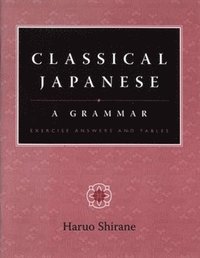
- Format
- Inbunden (Hardback)
- Språk
- Engelska
- Antal sidor
- 552
- Utgivningsdatum
- 2005-07-01
- Upplaga
- annotated ed
- Förlag
- Columbia University Press
- Originalspråk
- English
- Illustrationer
- none
- Dimensioner
- 284 x 218 x 35 mm
- Vikt
- Antal komponenter
- 1
- Komponenter
- Exercises and an answer booklet
- ISBN
- 9780231135245
- 1507 g
Classical Japanese
A Grammar
- Skickas från oss inom 5-8 vardagar.
- Fri frakt över 249 kr för privatkunder i Sverige.
Passar bra ihop
De som köpt den här boken har ofta också köpt The Anxious Generation av Jonathan Haidt (inbunden).
Köp båda 2 för 1149 krKundrecensioner
Fler böcker av Haruo Shirane
-
Japan and the Culture of the Four Seasons
Haruo Shirane
-
Early Modern Japanese Literature
Haruo Shirane
-
Traditional Japanese Literature
Haruo Shirane
-
The Tales of the Heike
Burton Watson, Haruo Shirane, Haruo Shirane
Recensioner i media
This comprehensive guide... includes in-depth explanations, exercises and literary excerpts useful to beginners as well as advanced speakers. Columbia College Today A significant contribution to the field of premodern Japanese language and literary studies. -- Stephen D. Miller Monumenta Nipponica
Övrig information
Haruo Shirane is Shincho Professor of Japanese Literature in the Department of East Asian Languages and Cultures at Columbia University. He is the author of The Bridge of Dreams: A Poetics of The Tale of Genji and Traces of Dreams: Landscape, Cultural Memory, and the Poetry of Basho; and an editor of Inventing the Classics: Modernity, National Identity, and Japanese Literature and Early Modern Japanese Literature: An Anthology, 1600-1900.
Innehållsförteckning
Preface Elements of the Book Grammatical Terms and Translations Major Historical Periods Romanization Source and Text Abbreviations Translations of Ranks and Titles Part I Inflected Forms 1. Basic Grammatical Terms and Concepts 1.1 Subject and Predicate 1.2 Sentence Structure 1.3 Autonomous and Dependent Forms 1.4 Inflected and Noninflected Forms 1.5 Inflected Autonomous Words 1.6 Inflected Dependent Forms 1.7 Noninflected Dependent Forms 1.8 Noninflected Autonomous Words 1.9 Modifying Words 1.10 Parts of Speech 2. Orthography and Pronunciation 2.1 Table of Fifty Sounds 2.2 Voiced Sounds 2.3 Sound Changes 2.4 Pronouncing Historical kana 2.4.1 w-Row Pronunciation 2.4.2 h-Row Pronunciation 2.5 Pronouncing Long Sounds 3. Verbs 3.1 The Six Inflected Forms 3.2 Regular Verbs 4. Irregular Verbs 4.2 Transitive and Intransitive Verbs 4.3 Supplementary Verbs 4.4 Sound Changes in Verbs 5. Adjectives and Adjectival Verbs 5.1 Adjectives 5.2 Adjectival Verbs 5.3 Two Modifying Functions 6. Negative and Recollective Auxiliary Verbs 6.1 Negative zu 6.2 Auxiliary Verbs ki and keri 7. Perfective and Continuative Auxiliary Verbs 7.1 Auxiliary Verbs nu and tsu 7.2 Resultative-Continuative Auxiliary Verbs tari and ri 8. Copular Auxiliary Verbs 9. Auxiliary Verbs of Speculation and Supposition 9.1 mu 9.2 muzu 9.3 kemu 9.4 ramu 9.5 rashi 9.6 mashi 9.7 beshi 9.8 meri 9.9 Hearsay nari 9.10 Summary of the Basic Functions of Speculative Auxiliary Verbs 10. Negative Speculative, Desirative, and Comparative Auxiliary Verbs 10.1 Negative Speculative Auxiliary Verbs ji and maji 10.2 Desirative Auxiliary Verbs tashi and mahoshi 10.3 Comparative Auxiliary Verb gotoshi 11. Passive-Causative Auxiliary Verbs 11.1 ru, raru 11.2 su, sasu, shimu 11.3 Summary of Auxiliary Verbs Part II Noninflected Forms 12. Case Particles 12.1 ga 12.2 no 12.3 o 12.3A o-ba 12.4 ni 12.5 e 12.6 to 12.7 yori 12.8 kara 12.8A kara-ni 12.9 shite 12.10 nite 13. Conjunctive Particles 13.1 ba 13.2 to, tomo 13.3 do, domo 13.4 ni, o 13.5 ga 13.6 te, shite 13.6A zu-te 13.6B te-wa 13.6C Conjunctive Particle te plus Supplementary Verb 13.7 de 13.8 tsutsu 13.9 nagara 13.10 mono-o, mono-kara, mono-no, mono-yue 13.11 Summary of Connections 14. Bound Particles 14.1 wa 14.2 mo 14.2A mo at the End of a Sentence 14.3 zo 14.3A zo at the End of a Sentence 14.4 namu (nan) 14.5 ya (yawa) 14.5A ya (yawa) at the End of a Sentence 14.6 ka (kawa) 14.6A ka (kawa) at the End of a Sentence 14.7 koso 14.7A A Bound Ending Without a Bound Particle 15. Adverbial Particles 15.1 sura 15.2 dani 15.3 sae 15.4 nomi 15.5 bakari 15.6 nado 15.7 made 15.8 shi, shimo 15.9 Note on Adverbial Particles Versus Adverbs 16. Final and Interjectory Particles 16.1 Final Particles 16.2 Interjectory Particles 16.3 Bound Particles at the Ends of Sentences 17. Nouns, Pronouns, Adverbs, Interjections, Conjunctions, and Attributive Words 17.1 Nouns 17.2 Pronouns 17.3 Adverbs 17.4 Interjections 17.5 Conjunctions 17.6 Attributive Words Part III Honorifics 18. Honorific Expressions 18.1 Noninflected Honorifics 18.2 Honorific Supplementary Verbs 18.3 Honorific Verbs 18.4 Honorific Auxiliary Verbs 19. Humble and Polite Expressions 19.1 Humble Verbs 19.1.1 tatematsuru 19.2 Mixing Honorific and Humble Forms 19.3 Summary of Key Honorific and Humble Verbs 19.4 Polite Verbs 20. Nara-Period Grammar 20.1 Auxiliary Verbs 20.2 Case Particles 20.3 Final Particles 20.3.1 kamo Part IV Appendixes Appendix 1. Review of the Six Inflections Appendix 2. Overview of Sound Changes Appendix 3. Prefixes and Suffixes Appendix 4. Supplementary Verbs Appendix 5. Rhetorical Techniques in Japanese Poetry Appendix 6. Easily Confused Elements Appendix 7. Auxiliary Verb Combinations Appendix 8. Conjugational Shifts A8.1 The Disappearance of Conjugation Types A8.2 The Growth of the Rentaikei Form A8.3 New Adjectival Forms Part V Grammar Exercises Tables of Grammatical Forms Table 1. Verb Conjugations Table 2. Adjectives and Adjectival Verb Forms Table 3. Sound Changes Tabl
Du kanske gillar
-
Atomic Habits
James Clear
Häftad


